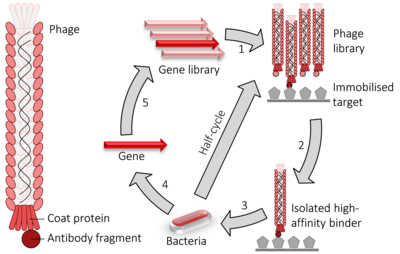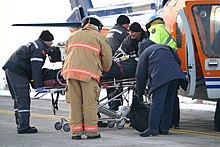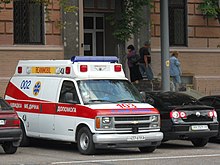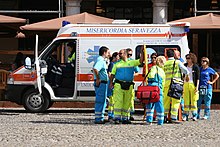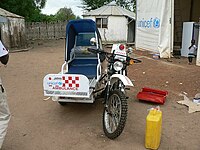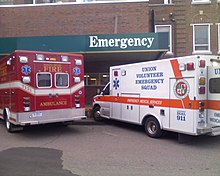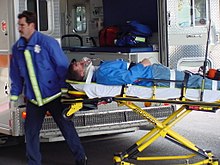Ambulances lined up in Tallahassee, FL prior to deployment during Hurricane Irma.
Emergency medical services prepare to airlift the victim of a car accident to hospital, in Ontario, Canada.
Emergency medical services (EMS), also known as ambulance services or paramedic services, are emergency services that provide urgent pre-hospital treatment and stabilisation for serious illness and injuries and transport to definitive care. They may also be known as a first aid squad, FAST squad, emergency squad, ambulance squad, ambulance corps, life squad or by other initialisms such as EMAS or EMARS.
In most places, the EMS can be summoned by members of the public
(as well as medical facilities, other emergency services, businesses and
authorities) via an emergency telephone number which puts them in contact with a control facility, which will then dispatch a suitable resource for the situation. Ambulances are the primary vehicles for delivering EMS, though some also use squad cars, motorcycles, aircraft, or boats. EMS agencies may also operate a non-emergency patient transport service, and some have rescue squads to provide technical rescue services.
As a first resort the EMS provide treatment on the scene to those in need of urgent medical care. If it is deemed necessary, they are tasked with transferring the patient to the next point of care. This is most likely an emergency department of a hospital. Historically, ambulances only transported patients to care, and this remains the case in parts of the developing world.
The term "emergency medical service" was popularised when these
services began to emphasise diagnosis and treatment at the scene. In
some countries, a substantial portion of EMS calls do not result in a
patient being taken to hospital.
Training and qualification
levels for members and employees of emergency medical services vary
widely throughout the world. In some systems, members may be present who
are qualified only to drive ambulances, with no medical training. In contrast, most systems have personnel who retain at least basic first aid certifications, such as basic life support (BLS). In English-speaking countries, they are known as emergency medical technicians (EMTs) and paramedics, with the latter having additional training such as advanced life support (ALS) skills. Physicians and nurses also provide pre-hospital care to varying degrees in different countries.
History
Precursors
Emergency care in the field has been rendered in different forms since the beginning of recorded history. The New Testament contains the parable of the Good Samaritan,
in which a man who has been beaten is cared for by a passing Samaritan.
Luke 10:34 (NIV) – "He went to him and bandaged his wounds, pouring on
oil and wine. Then he put the man on his own donkey, took him to an inn
and took care of him." During the Middle Ages, the Knights Hospitaller were known for rendering assistance to wounded soldiers in the battlefield.
A drawing of one of Larrey's ambulances volantes.
The first use of the ambulance as a specialized vehicle, in battle came about with the ambulances volantes designed by Dominique Jean Larrey (1766–1842), Napoleon Bonaparte's chief surgeon. Larrey was present at the battle of Spires, between the French and Prussians,
and was distressed by the fact that wounded soldiers were not picked up
by the numerous ambulances (which Napoleon required to be stationed two
and half miles back from the scene of battle) until after hostilities
had ceased, and set about developing a new ambulance system. Having decided against using the Norman system of horse litters, he settled on two- or four-wheeled horse-drawn wagons, which were used to transport fallen soldiers from the (active) battlefield after they had received early treatment in the field. Larrey's projects for 'flying ambulances' were first approved by the Committee of Public Safety
in 1794. Larrey subsequently entered Napoleon's service during the
Italian campaigns in 1796, where his ambulances were used for the first
time at Udine, Padua and Milan, and he adapted his ambulances to the
conditions, even developing a litter which could be carried by a camel for a campaign in Egypt.
Early civilian ambulances
A
major advance was made (which in future years would come to shape
policy on hospitals and ambulances) with the introduction of a transport
carriage for cholera patients in London during 1832. The statement on the carriage, as printed in The Times,
said "The curative process commences the instant the patient is put in
to the carriage; time is saved which can be given to the care of the
patient; the patient may be driven to the hospital so speedily that the
hospitals may be less numerous and located at greater distances from
each other".
This tenet of ambulances providing instant care, allowing hospitals to
be spaced further apart, displays itself in modern emergency medical
planning.
The first known hospital-based ambulance service operated out of Commercial Hospital, Cincinnati, Ohio (now the Cincinnati General) by 1865. This was soon followed by other services, notably the New York service provided out of Bellevue Hospital which started in 1869 with ambulances carrying medical equipment, such as splints, a stomach pump, morphine, and brandy, reflecting contemporary medicine.
Another early ambulance service was founded by Jaromir V. Mundy, Count J. N. Wilczek, and Eduard Lamezan-Salins in Vienna after the disastrous fire at the Vienna Ringtheater in 1881. Named the "Vienna Voluntary Rescue Society," it served as a model for similar societies worldwide.
In June 1887 the St John Ambulance Brigade was established to provide first aid and ambulance services at public events in London. It was modelled on a military-style command and discipline structure.
Motorization
Also in the late 19th century, the automobile was being developed, and in addition to horse-drawn models, early 20th century ambulances were powered by steam, gasoline, and electricity,
reflecting the competing automotive technologies then in existence.
However, the first motorized ambulance was brought into service in the
last year of the 19th century, with the Michael Reese Hospital, Chicago, taking delivery of the first automobile ambulance, donated by 500 prominent local businessmen, in February 1899.
This was followed in 1900 by New York City, who extolled its virtues
of greater speed, more safety for the patient, faster stopping and a
smoother ride. These first two automobile ambulances were electrically
powered with 2 hp motors on the rear axle.
During World War I, further advances were made in providing care before and during transport; traction splints were introduced during the war and were found to have a positive effect on the morbidity and mortality of patients with leg fractures. Two-way radios became available shortly after World War I, enabling for more efficient radio dispatch of ambulances in some areas. Prior to World War II, there were some areas where a modern ambulance carried advanced medical equipment, was staffed by a physician, and was dispatched by radio. In many locations, however, ambulances were hearses, the only available vehicle that could carry a recumbent patient, and were thus frequently run by funeral homes. These vehicles, which could serve either purpose, were known as combination cars.
Prior to World War II, hospitals provided ambulance service in
many large cities. With the severe manpower shortages imposed by the war
effort, it became difficult for many hospitals to maintain their
ambulance operations. City governments in many cases turned ambulance
services over to the police or fire department. No laws required minimal
training for ambulance personnel and no training programs existed
beyond basic first aid. In many fire departments, assignment to
ambulance duty became an unofficial form of punishment.
Rise of modern EMS
A 1973
Cadillac Miller-Meteor ambulance. Note the raised roof, with more room for the attendants and patients
Advances in the 1960s, especially the development of CPR and defibrillation as the standard form of care for out-of-hospital cardiac arrest, along with new pharmaceuticals, led to changes in the tasks of the ambulances. In Belfast, Northern Ireland the first experimental mobile coronary care ambulance successfully resuscitated patients using these technologies. Freedom House Ambulance Service was the first civilian emergency medical service in the United States to be staffed by paramedics, most of which were black.
One well-known report in the US during that time was Accidental Death and Disability: The Neglected Disease of Modern Society, also known as The White Paper. The report concluded that ambulance services in the US varied widely in quality and were often unregulated and unsatisfactory.[25]
These studies placed pressure on governments to improve emergency care
in general, including the care provided by ambulance services. The
government reports resulted in the creation of standards
in ambulance construction concerning the internal height of the patient
care area (to allow for an attendant to continue to care for the
patient during transport), and the equipment (and thus weight) that an
ambulance had to carry, and several other factors.
In 1971 a progress report was published at the annual meeting, by
the then president of American Association of Trauma, Sawnie R. Gaston
M.D. Dr. Gaston reported the study was a "superb white paper" that
"jolted and wakened the entire structure of organized medicine." This
report is created as a "prime mover" and made the "single greatest
contribution of its kind to the improvement of emergency medical
services". Since this time a concerted effort has been undertaken to
improve emergency medical care in the pre-hospital setting. Such advancements included Dr. R Adams Cowley creating the country's first statewide EMS program, in Maryland.
The developments were paralleled in other countries. In the
United Kingdom, a 1973 law merged the municipal ambulance services into
larger agencies and set national standards. In France, the first official SAMU agencies were founded in the 1970s.
Organization
Depending
on country, area within country, or clinical need, emergency medical
services may be provided by one or more different types of organization.
This variation may lead to large differences in levels of care and
expected scope of practice. Some countries closely regulate the industry
(and may require anyone working on an ambulance to be qualified to a
set level), whereas others allow quite wide differences between types of
operator.
Government ambulance service
Operating separately from (although alongside) the fire and police
services of the area, these ambulances are funded by local, provincial
or national governments. In some countries, these only tend to be found
in big cities, whereas in countries such as the United Kingdom, almost
all emergency ambulances are part of a national health system.
In the United States, ambulance services provided by a local
government are often referred to as "third service" EMS (the fire
department, police department, and separate EMS forming an emergency
services trio) by the employees of said service, as well as other city
officials and residents. The most notable examples of this model in the
United States are Pittsburgh Bureau of Emergency Medical Services (PEMS), Boston EMS, New Orleans Emergency Medical Services, Austin-Travis County Emergency Medical Services, Cleveland EMS, Wake County Emergency Medical Services and Honolulu EMS Archived 3 April 2022 at the Wayback Machine.
Government ambulance services also have to take civil service exams
just like government fire departments and police. In the United States,
certain federal government agencies employ emergency medical technicians
at the basic and advanced life support levels, such as the National Park Service and the Federal Bureau of Prisons.
Fire- or police-linked service
In
countries such as the United States, Japan, France, South Korea and
parts of India, ambulances can be operated by the local fire or police
services. Fire-based EMS is the most common model in the United States,
where nearly all urban fire departments provide EMS
and a majority of emergency transport ambulance services in large
cities are part of fire departments. It is somewhat rare for a police
department in the United States to provide EMS or ambulance services,
although many police officers have basic medical training. One notable
example is New Orleans Emergency Medical Services, which was formed as a hospital-based service, was operated by the New Orleans Police Department
from 1947 to 1985, and is currently operated by the New Orleans Health
Department and the New Orleans Office of Homeland Security and Emergency
Preparedness, separate from the New Orleans Fire Department.
Charity ambulance service
A volunteer ambulance crew in
Modena, Italy
Charities or non-profit companies operate some emergency medical services. They are primarily staffed by volunteers, though some have paid personnel. These may be linked to a volunteer fire service,
and some volunteers may provide both services. Some ambulance charities
specialize in providing cover at public gatherings and events (e.g.
sporting events), while others provide care to the wider community.
The International Red Cross and Red Crescent Movement is the largest charity in the world that provides emergency medicine. (in some countries, it operates as a private ambulance service). Other organisations include St John Ambulance, the Order of Malta Ambulance Corps and Hatzalah,
as well as small local volunteer agencies. In the United States,
volunteer ambulances are rarer, but can still be seen in both
metropolitan and rural areas (e.g. Hatzalah). Charities such as BASICS Scotland,
specialise in facilitating training medical professionals to volunteer
to assist the statutory ambulance services in the care of patients,
through their attendance at those with serious illnesses or injuries.
A few charities provide ambulances for taking patients on trips
or vacations away from hospitals, hospices or care homes where they are
in long-term care. Examples include the UK's Jumbulance project.
Private ambulance service
Some
ambulances are operated by commercial companies with paid employees,
usually on a contract to the local or national government, Hospital
Networks, Health Care Facilities and Insurance Companies.
In the USA private ambulance companies provide 911 emergency
services in large cities as well as most rural areas by contracting with
local governments. In areas that the local County or City provide their
own 911 service, private companies provide discharges and transfers
from hospitals and to/from other health related facilities and homes. In
most areas private companies are part of the local government Emergency
Disaster plan, and are relied upon heavily for the overall EMS
response, treatment and recovery.
In some areas, private companies may provide only the patient
transport elements of ambulance care (i.e. non-urgent), but in some
places, they are contracted to provide emergency care, or to form a
'second tier' response, where they only respond to emergencies when all
of the full-time emergency ambulance crews are busy. This may mean that a
government or other service provide the 'emergency' cover, whilst a
private firm may be charged with 'minor injuries' such as cuts, bruises
or even helping the mobility-impaired if they have for example fallen
and simply need help to get up again, but do not need treatment. This
system has the benefit of keeping emergency crews available at all times
for genuine emergencies. These organisations may also provide services
known as 'Stand-by' cover at industrial sites or at special events. In Latin America, private ambulance companies are often the only readily-available EMS service
Combined emergency service
These
are full service emergency service agencies, which may be found in
places such as airports or large colleges and universities. Their key
feature is that all personnel are trained not only in ambulance (EMT)
care, but as a firefighter and a peace officer (police function). They
may be found in smaller towns and cities, where demand or budget is too
low to support separate services. This multi-functionality allows to
make the most of limited resource or budget, but having a single team
respond to any emergency.
Hospital-based service
Hospitals
may provide their own ambulance service as a service to the community,
or where ambulance care is unreliable or chargeable. Their use would be
dependent on using the services of the providing hospital.
Internal ambulances
Many large factories and other industrial centres, such as chemical plants, oil refineries, breweries and distilleries
have ambulance services provided by employers as a means of protecting
their interests and the welfare of their staff. These are often used as
first response vehicles in the event of a fire or explosion.
Purpose
Six points on the Star of Life
Emergency medical services exists to fulfill the basic principles of first aid, which are to Preserve Life, Prevent Further Injury, and Promote Recovery.
This common theme in medicine is demonstrated by the "star of life". The Star of Life
shown here, where each of the 'arms' to the star represent one of the
six points, are used to represent the six stages of high quality
pre-hospital care, which are:
- Early detection – members of the public, or another agency, find the incident and understand the problem
- Early reporting – the first persons on scene make a call to
the emergency medical services (911) and provide details to enable a
response to be mounted
- Early response – the first professional (EMS) rescuers are dispatched and arrive on scene as quickly as possible, enabling care to begin
- Good on-scene/field care – the emergency medical service
provides appropriate and timely interventions to treat the patient at
the scene of the incident without doing further harm.
- Care in transit -– the emergency medical service load the
patient in to suitable transport and continue to provide appropriate
medical care throughout the journey
- Transfer to definitive care – the patient is handed over to
an appropriate care setting, such as the emergency department at a
hospital, in to the care of physicians
Strategies for delivering care
Although a variety of differing philosophical
approaches are used in the provision of EMS care around the world, they
can generally be placed into one of two categories; one physician-led and the other led by pre-hospital allied health staff such as emergency medical technicians or paramedics. These models are commonly referred to as the Franco-German model and Anglo-American model.
Studies have been inconclusive as to whether one model delivers better results than the other. A 2010 study in the Oman Medical Journal
suggested that rapid transport was a better strategy for trauma cases,
while stabilization at the scene was a better strategy for cardiac
arrests.
Levels of care
Many systems have tiers of response for medical emergencies. For
example, a common arrangement in the United States is that fire engines
or volunteers are sent to provide a rapid initial response to a medical
emergency, while an ambulance is sent to provide advanced treatment and
transport the patient. In France, fire service and private company
ambulances provide basic care, while hospital-based ambulances with
physicians on board provide advanced care. In many countries, an air ambulance provides a higher level of care than a regular ambulance.
Examples of level of care include:
- First aid consists of basic skills that are commonly taught to members of the public, such as cardiopulmonary resuscitation, bandaging wounds and saving someone from choking.
- Basic Life Support (BLS) is often the lowest level of training that can be held by those who treat patients on an ambulance. Commonly, it includes administering oxygen therapy,
some drugs and a few invasive treatments. BLS personnel may either
operate a BLS ambulance on their own, or assist a higher qualified
crewmate on an ALS ambulance. In English-speaking countries, BLS
ambulance crew are known as emergency medical technicians or emergency care assistants.
- Intermediate Life Support
(ILS), also known as Limited Advanced Life Support (LALS), is
positioned between BLS and ALS but is less common than both. It is
commonly a BLS provider with a moderately expanded skill set, but where
it is present it usually replaces BLS.
- Advanced Life Support (ALS) has a considerably expanded range of skills such as intravenous therapy, cricothyrotomy and interpreting an electrocardiogram. The scope of this higher tier response varies considerably by country. Paramedics commonly provide ALS, but some countries require it to be a higher level of care and instead employ physicians
in this role. Additionally Advanced Life Support includes administering
therapeutic doses of electrical shock to those who are in cardiac
arrest or using drugs to stimulate the heart, Airway therapy, and so on
and so forth. Most ambulances are equipped with advanced Life Support
equipment and have paramedics on board. While some fire departments have
ambulances, first aid and squads utilize ambulances for emergency
medical services.
- Critical Care Transport (CCT), also known as medical retrieval or
rendez vous MICU protocol in some countries (Australia, NZ, Great
Britain, and Francophone Canada) refers to the critical care transport
of patients between hospitals (as opposed to pre-hospital). Such
services are a key element in regionalized systems of hospital care
where intensive care services are centralized to a few specialist
hospitals. An example of this is the Emergency Medical Retrieval Service
in Scotland. This level of care is likely to involve traditional
healthcare professionals (in addition to or instead of critical
care-trained paramedics), meaning nurses and/or physicians working in the pre-hospital setting and even on ambulances.
Transport-only
The most basic emergency medical services are provided as a transport
operation only, simply to take patients from their location to the
nearest medical treatment. This was historically the case in all
countries. It remains the case in much of the developing world, where
operators as diverse as taxi drivers and undertakers may transport people to hospital.
Transport-centered EMS
Ambulances parked outside a local emergency room.
The Anglo-American model is also known as "load and go" or "scoop and run". In this model, ambulances are staffed by paramedics and/or emergency medical technicians.
They have specialized medical training, but not to the same level as a
physician. In this model it is rare to find a physician actually working
routinely in ambulances, although they may be deployed to major or
complex cases. The physicians who work in EMS provide oversight for the work of the ambulance crews. This may include off-line medical control, where they devise protocols
or 'standing orders' (procedures for treatment). This may also include
on-line medical control, in which the physician is contacted to provide
advice and authorization for various medical interventions.
In some cases, such as in the UK, South Africa and Australia, a paramedic
may be an autonomous health care professional, and does not require the
permission of a physician to administer interventions or medications
from an agreed list, and can perform roles such as suturing or
prescribing medication to the patient.
Recently "Telemedicine" has been making an appearance in ambulances.
Similar to online medical control, this practice allows paramedics to
remotely transmit data such as vital signs and 12 and 15 lead ECGs to
the hospital from the field. This allows the emergency department to
prepare to treat patients prior to their arrival.
This is allowing lower level providers (Such as EMT-B) in the United
States to utilize these advanced technologies and have the doctor
interpret them, thus bringing rapid identification of rhythms to areas
where paramedics are stretched thin. While most insurance companies only reimburse EMS providers for transporting patients to 911 receiving facilities (e.g. Emergency Departments),the Center to Medicare and Medicaid Services is in the process of evaluating a payment model to enable reimbursement for patients evaluated and treated on-scene.
Major trauma
The essential decision in prehospital care is whether the patient should be immediately taken to the hospital, or advanced care resources are taken to the patient where they lie. The "scoop and run" approach is exemplified by the MEDEVAC aeromedical evacuation helicopter, whereas the "stay and play" is exemplified by the French and Belgian SMUR emergency mobile resuscitation unit or the German "Notarzt"-System (preclinical emergency physician).
The strategy developed for prehospital trauma care in North America is based on the Golden Hour theory, i.e., that a trauma victim's best chance for survival is in an operating room,
with the goal of having the patient in surgery within an hour of the
traumatic event. This appears to be true in cases of internal bleeding,
especially penetrating trauma such as gunshot or stab wounds. Thus,
minimal time is spent providing prehospital care (spine immobilization;
"ABCs", i.e. ensure airway, breathing and circulation; external bleeding control; endotracheal intubation) and the victim is transported as fast as possible to a trauma centre.
The aim in "Scoop and Run" treatment is generally to transport
the patient within ten minutes of arrival, hence the birth of the
phrase, "the platinum ten minutes" (in addition to the "golden hour"),
now commonly used in EMT training programs. The "Scoop and Run" is a
method developed to deal with trauma,
rather than strictly medical situations (e.g. cardiac or respiratory
emergencies), however, this may be changing. Increasingly, research into
the management of S-T segment elevation myocardial infarctions (STEMI) occurring outside of the hospital, or even inside community hospitals without their own PCI
labs, suggests that time to treatment is a clinically significant
factor in heart attacks, and that trauma patients may not be the only
patients for whom 'load and go' is clinically appropriate. In such
conditions, the gold standard is the door to balloon time. The longer the time interval, the greater the damage to the myocardium, and the poorer the long-term prognosis for the patient.
Current research in Canada has suggested that door to balloon times are
significantly lower when appropriate patients are identified by
paramedics in the field, instead of the emergency room, and then
transported directly to a waiting PCI lab. The STEMI program has reduced STEMI deaths in the Ottawa region by 50 per cent.
In a related program in Toronto, EMS has begun to use a procedure of
'rescuing' STEMI patients from the Emergency Rooms of hospitals without
PCI labs, and transporting them, on an emergency basis, to waiting PCI
labs in other hospitals.
Physician-led EMS
Physician-led EMS is also known as the Franco-German model, "stay and play", "stay and stabilize" or "delay and treat". In a physician-led system, doctors respond directly to all major emergencies requiring more than simple first aid.
The physicians will attempt to treat casualties at the scene and will
only transport them to hospital if it is deemed necessary. If patients
are transported to hospital, they are more likely to go straight to a
ward rather than to an emergency department. Countries that use this model include Austria, France, Belgium, Luxembourg, Italy, Spain, Brazil and Chile.
In some cases in this model, such as France, there is no direct equivalent to a paramedic. Physicians and (in some cases) nurses
provide all medical interventions for the patient. Other ambulance
personnel are not non-medically trained and only provide driving and
heavy lifting. In other applications of this model, as in Germany, a
paramedic equivalent does exist, but is an assistant to the physician
with a restricted scope of practice. They are only permitted to perform Advanced Life Support (ALS) procedures if authorized by the physician, or in cases of immediate life-threatening conditions. Ambulances
in this model tend to be better equipped with more advanced medical
devices, in essence, bringing the emergency department to the patient.
High-speed transport to hospitals is considered, in most cases, to be
unnecessarily unsafe, and the preference is to remain and provide
definitive care to the patient until they are medically stable, and then
accomplish transport. In this model, the physician and nurse may
actually staff an ambulance along with a driver, or may staff a rapid
response vehicle instead of an ambulance, providing medical support to
multiple ambulances.
Personnel
A patient arriving at hospital
Ambulance personnel are generally professionals and in some countries
their use is controlled through training and registration. While these
job titles are protected by legislation in some countries, this
protection is by no means universal, and anyone might, for example, call
themselves an 'EMT' or a 'paramedic', regardless of their training, or
the lack of it. In some jurisdictions, both technicians and paramedics
may be further defined by the environment in which they operate,
including such designations as 'Wilderness', 'Tactical', and so on.
A unique aspect of EMS is that there are two hierarchies of authority, as the chain of command is separate to medical authority.
Basic life support (BLS)
First responder
Certified first responders may be sent to provide first aid,
sometimes to an advanced level. Their duties include the provision of
immediate life-saving care in the event of a medical emergency; commonly
advanced first aid, oxygen administration, cardio-pulmonary resuscitation (CPR), and automated external defibrillator
(AED) usage. The first responder training is considered a bare minimum
for emergency service workers who may be sent out in response to an emergency call.
First responders are commonly dispatched by the ambulance service to
arrive quickly and stabilize the patient before the ambulance arrives,
and to then assist the ambulance crew.
Some EMS agencies have set up volunteer schemes, who can be
dispatched to a medical emergency before the ambulance arrives. Examples
of this include Community First Responder schemes run by ambulance services the UK and similar volunteer schemes
operated by the fire services in France. In some countries such as the
US, there may be autonomous groups of volunteer responders such as rescue squads. Police officers and firefighters
who are on duty for another emergency service may also be deployed in
this role, though some firefighters are trained to a more advanced
medical level.
Besides first responders who are deployed to an emergency, there are others who may be stationed at public events. The International Red Cross and Red Crescent Movement and St John Ambulance both provide first aiders in these roles.
Driver
Some
agencies separate the 'driver' and 'attendant' functions, employing
ambulance driving staff with no medical qualification (or just a first
aid and CPR certificates), whose job is to drive ambulances. While this
approach persists in some countries, such as India, it is generally
becoming increasingly rare. Ambulance drivers may be trained in radio
communications, ambulance operations and emergency response driving
skills.
Non-emergency driver/attendant
Many
countries employ ambulance staff who only carry out non-emergency
patient transport duties (which can include stretcher or wheelchair
cases). Dependent on the provider (and resources available), they may be
trained in first aid or extended skills such as use of an AED, oxygen therapy, pain relief and other live-saving or palliative
skills. In some services, they may also provide emergency cover when
other units are not available, or when accompanied by a fully qualified
technician or paramedic. The role is known as an Ambulance Care
Assistant in the United Kingdom.
Emergency medical technician
EMTs loading a patient into an ambulance
Emergency medical technicians,
also known as Ambulance Technicians in the UK and EMT in the United
States. In the United States, EMT is usually made up of 3 levels. EMT-B,
EMT-I (EMT-A in some states) and EMT-Paramedic. The National Registry
of EMT New Educational Standards for EMS renamed the provider levels as
follows: Emergency Medical Responder (EMR), Emergency Medical Technician
(EMT), Advanced EMT (AEMT), and Paramedic. EMTs are usually able to
perform a wide range of emergency care skills, such as automated defibrillation, care of spinal injuries and oxygen therapy.
In few jurisdictions, some EMTs are able to perform duties as IV and
IO cannulation, administration of a limited number of drugs (including
but not limited to Epinephrine, Narcan, Oxygen, Aspirin, Nitroglycerin -
dependent on country, state, and medical direction), more advanced
airway procedures, CPAP, and limited cardiac monitoring. Most advanced procedures and skills are not within the national scope of practice for an EMT. As such most states require additional training and certifications to perform above the national curriculum standards.
In the US, an EMT certification requires intense courses and training
in field skills. A certification expires after two years and holds a
requirement of taking 48 CEUs (continuing education credits). 24 of
these credits must be in refresher courses while the other 24 can be
taken in a variety ways such as emergency driving training, pediatric,
geriatric, or bariatric care, specific traumas, etc.
Emergency medical dispatcher
An
emergency medical dispatcher is also called an EMD. An increasingly
common addition to the EMS system is the use of highly trained dispatch
personnel who can provide "pre-arrival" instructions to callers
reporting medical emergencies. They use carefully structured questioning
techniques and provide scripted instructions to allow callers or
bystanders to begin definitive care for such critical problems as airway
obstructions, bleeding, childbirth, and cardiac arrest. Even with a
fast response time
by a first responder measured in minutes, some medical emergencies
evolve in seconds. Such a system provides, in essence, a "zero response
time," and can have an enormous impact on positive patient outcomes.
Advanced life support (ALS)
Paramedic
A girl treated by a paramedic
A paramedic
has a high level of pre-hospital medical training and usually involves
key skills not performed by technicians, often including cannulation (and with it the ability to use a range of drugs to relieve pain, correct cardiac problems, and perform endotracheal intubation), cardiac monitoring, ultrasound, intubation, pericardiocentesis, cardioversion, thoracostomy, and other skills such as performing a surgical cricothyrotomy.
The most important function of the paramedic is to identify and treat
any life-threatening conditions and then to assess the patient carefully
for other complaints or findings that may require emergency treatment.
In many countries, this is a protected title, and use of it without the
relevant qualification may result in criminal prosecution.
In the United States, paramedics represent the highest licensure level
of prehospital emergency care. In addition, several certifications exist
for Paramedics such as Wilderness ALS Care, Flight Paramedic Certification (FP-C), and Critical Care Emergency Medical Transport Program certification.
Critical care paramedic
A critical care paramedic, also known as an advanced practice
paramedic or specialist paramedic, is a paramedic with additional
training to deal with critically ill patients. Critical care paramedics often work on air ambulances, which are more likely to be dispatched to emergencies requiring advanced care skills. They may also work on land ambulances.
The training, permitted skills, and certification requirements vary
from one jurisdiction to the next. It also varies to whether they are
trained externally by a university or professional body or 'in house' by their EMS agency.
These providers have a vast array of and medications to handle complex medical and trauma patients. Examples of medication are dopamine, dobutamine, propofol, blood and blood products
to name just a few. Some examples of skills include, but not limited
to, life support systems normally restricted to the ICU or critical care
hospital setting such as mechanical ventilators, Intra-aortic balloon pump (IABP) and external pacemaker monitoring. Depending on the service medical direction, these providers are trained on placement and use of UVCs (Umbilical Venous Catheter), UACs (Umbilical Arterial Catheter), surgical airways, central lines, arterial lines and chest tubes.
Paramedic practitioner / emergency care practitioner
In the United Kingdom and South Africa, some serving paramedics
receive additional university education to become practitioners in
their own right, which gives them absolute responsibility for their
clinical judgement, including the ability to autonomously prescribe
medications, including drugs usually reserved for doctors, such as
courses of antibiotics. An emergency care practitioner is a position that is designed to bridge the link between ambulance care and the care of a general practitioner. ECPs are university graduates in Emergency Medical Care or qualified paramedics who have undergone further training,
and are authorized to perform specialized techniques. Additionally some
may prescribe medicines (from a limited list) for longer-term care,
such as antibiotics. With respect to a Primary Health Care setting, they
are also educated in a range of Diagnostic techniques.
Traditional healthcare professions
Registered nurses
The use of registered nurses
(RNs) in the pre-hospital setting is common in many countries in
absence of paramedics. In some regions of the world nurses are the
primary healthcare worker that provides emergency medical services. In
European countries such as France or Italy, also use nurses as a means
of providing ALS services. These nurses may work under the direct
supervision of a physician, or, in rarer cases, independently. In some
places in Europe, notably Norway, paramedics do exist, but the role of
the 'ambulance nurse' continues to be developed, as it is felt that nurses may bring unique skills to some situations encountered by ambulance crews.
In North America, and to a lesser extent elsewhere in the
English-speaking world, some jurisdictions use specially trained nurses
for medical transport work. These are mostly air-medical personnel or
critical care transport providers, often working in conjunction with a
technician, paramedic or physician on emergency interfacility
transports. In the United States, the most common uses of
ambulance-based registered nurses is in the Critical Care/Mobile
Intensive Care transport, and in Aeromedical EMS. Such nurses are
normally required by their employers (in the US) to seek additional
certifications beyond the primary nursing licensure. Four individual
states have an Intensive Care or Prehospital Nurse licensure. Many
states allow registered nurses to also become registered paramedics
according to their role in the emergency medical services team. In Estonia
60% of ambulance teams are led by nurse. Ambulance nurses can do almost
all emergency procedures and administer medicines pre-hospital such as
physicians in Estonia. In the Netherlands,
all ambulances are staffed by a registered nurse with additional
training in emergency nursing, anaesthesia or critical care, and a
driver-EMT. In Sweden,
since 2005, all emergency ambulances should be staffed by at least one
registered nurse since only nurses are allowed to administer drugs. And all Advanced Life Support Ambulances are staffed at least by a registered nurse in Spain.
In France, since 1986, fire department-based rescue ambulances have had
the option of providing resuscitation service (reanimation) using
specially trained nurses, operating on protocols, while SAMU-SMUR units are staffed by physicians and nurses
Physician
In countries with a physician-led
EMS model, such as France, Italy, the German-speaking countries
(Germany, Switzerland, Austria), and Spain, physicians respond to all
cases that require more than basic first aid. In some versions of this
model (such as France, Italy, and Spain), there is no direct equivalent
to a paramedic,
as ALS is performed by physicians. In the German-speaking countries,
paramedics are assistants to ambulance physicians (called Notarzt). In
these countries, if a physician is present, paramedics require
permission from the physician to administer treatments such as
defibrillation and drugs. If there is no physician on scene and a
life-threatening condition is present, they may administer treatments
that follow the physician's instructions.
In countries where EMS is led by paramedics, the ambulance
service may still employ physicians. They may serve on specialist
response vehicles, such as the air ambulances in the UK. They may also provide advice and devise protocols for treatment, with a medical director
acting as the most senior medical adviser to the ambulance service. In
the United States, EMS became an officially recognized subspecialty by
the American Board of Emergency Medicine in 2010, and the first
examinations were held in 2013. Many states now recommend EMS board certifiction for newly hired Medical Directors of EMS agencies.
Specialist EMS
Air ambulance
Air ambulances often complement a land ambulance service. In some
remote areas, they may even form the primary ambulance service. Like
many innovations in EMS, medical aircraft were first used in the
military. One of the first recorded aircraft rescues of a casualty was
in 1917 in Turkey, when a soldier in the Camel Corps who had been shot in the ankle was flown to hospital in a de Havilland DH9. In 1928, the first civilian air medical service was founded in Australia to provide healthcare to people living in remote parts of the Outback. This service became the Royal Flying Doctor Service. The use of helicopters was pioneered in the Korean War, when time to reach a medical facility was reduced from 8 hours to 3 hours in World War II, and again to 2 hours by the Vietnam War.
Aircraft can travel faster and operate in a wider coverage area than a land ambulance. They have a particular advantage for major trauma injuries. The well-established theory of the golden hour suggests that major trauma patients should be transported as quickly as possible to a specialist trauma center. Therefore, medical responders in a helicopter can provide both a higher
level of care at the scene, faster transport to a specialist hospital and critical care during the journey. A disadvantage is that it can be dangerous and potentially not possible for them to fly at night or in bad weather.
Tactical (hazardous area)
Some EMS agencies have set up specialist teams to help those injured in a major incident or a dangerous situation. These include tactical police operations, active shooters, bombings, hazmat situations, building collapses, fires and natural disasters. In the US, these are often known as Tactical EMS teams and are often deployed alongside police SWAT teams. The equivalent in UK ambulance services is a Hazardous Area Response Team (HART).
Wilderness
Wilderness
EMS-like systems (WEMS) have been developed to provide medical
responses in remote areas, which may have significantly different needs
to an urban area. Examples include the
National Ski Patrol
or the regional-responding Appalachian Search and Rescue Conference
(USA based). Like traditional EMS providers, all wilderness emergency
medical (WEM) providers must still operate under on-line or off-line
medical oversight. To assist physicians in the skills necessary to
provide this oversight, the
Wilderness Medical Society
and the National Association of EMS Physicians jointly supported the
development in 2011 of a unique "Wilderness EMS Medical Director"
certification course, which was cited by the Journal of EMS as one of the Top 10 EMS Innovations of 2011.
Skills taught in WEMT courses exceeding the EMT-Basic scope of practice
include catheterization, antibiotic administration, use of intermediate
Blind Insertion Airway Devices (i.e.
King Laryngeal Tube),
Nasogastric Intubation, and simple suturing;
however, the scope of practice for the WEMT still falls under BLS level
care. A multitude of organizations provide WEM training, including
private schools, non-profit organizations such as the
Appalachian Center for Wilderness Medicine and the Wilderness EMS Institute, military branches, community colleges and universities, EMS-college-hospital collaborations, and others.
